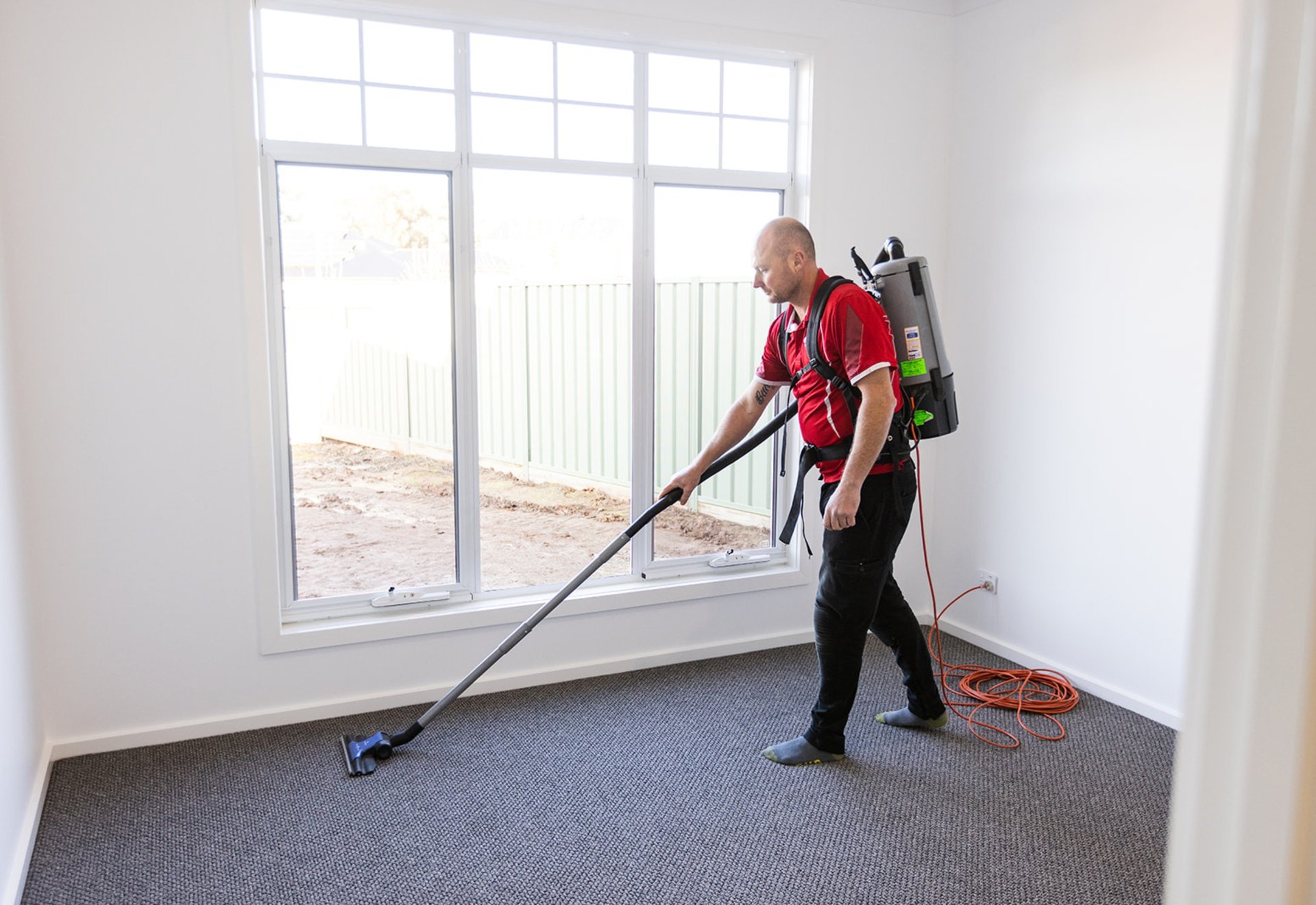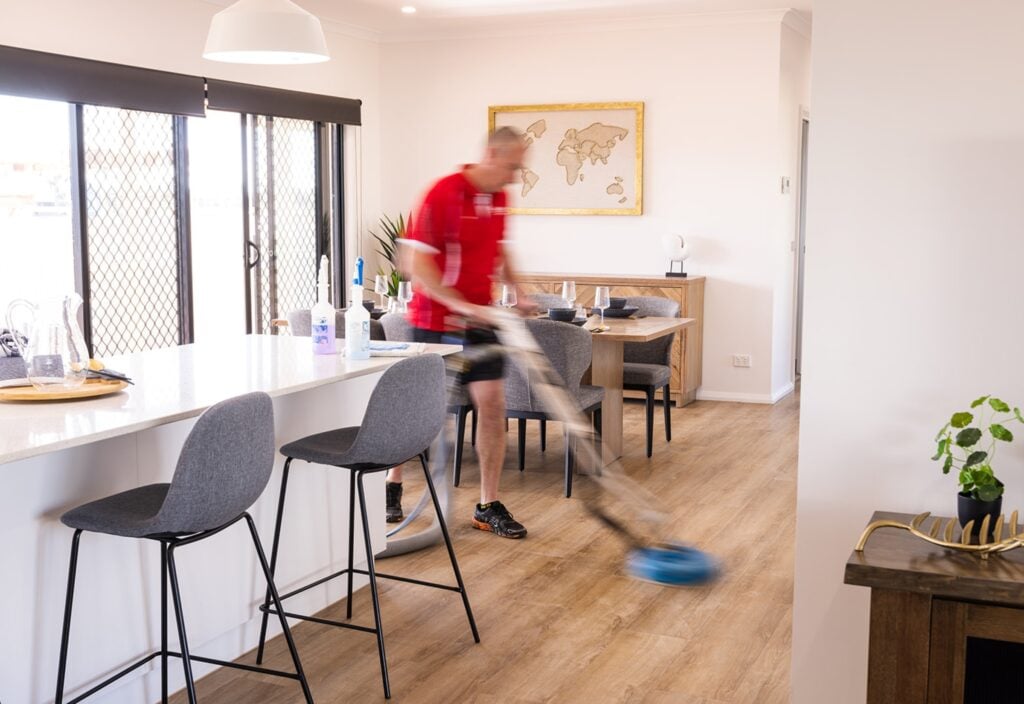It’s a moment of pure, slow-motion horror.
The glass tips, the dark liquid arcs through the air, and it lands. Right on the cream-coloured carpet. Whether it’s a splash of red wine, a toppled cup of coffee, or a “present” from a new puppy, the result is the same: panic.
We’ve all been there. Our carpets and sofas are the landscapes of our lives. They catch the crumbs from movie nights, the dirt from the garden, and the evidence of every spill and mishap. Over time, that dark spot by the sofa is no longer a “stain”; it’s just a “feature.”
But here’s the problem. The stains you can see are only half the story. The real issue is the “iceberg” of dirt, grime, and allergens lurking just beneath the surface.
Your carpet is the biggest air filter in your home. It traps dust, pollen, pet dander, bacteria, and microscopic skin cells. And in that cosy, fibrous environment, a whole ecosystem of dust mites is thriving. (Sorry, it’s gross, but it’s true).
This guide is your two-part battle plan. First, we’ll cover the emergency “first-aid” for those heart-stopping spills. Second, we’ll explain why your domestic vacuum and that rental machine are losing the war—and how professional carpet cleaning is the only way to win your home’s health back.
The “Iceberg” in Your Living Room: What’s Really Hiding in Your Carpet?
You vacuum every week, so your carpets are clean, right?
Unfortunately, no. Most domestic vacuums only have enough suction to remove the loose, surface-level dirt. They lack the power to pull out the heavy, embedded grit that sinks to the very base of the carpet fibres.
Worse, many standard vacuums simply blast the finest particles—the allergens—back into the air, which is why you can often smell that “musty” vacuum smell.
Here’s a look at what you’re really living with:
- Dust Mites: These microscopic critters are one of the most common triggers for asthma and allergies in Australia. According to Asthma Australia, they thrive in warm, humid environments (hello, Queensland!) and feed on the dead skin cells we shed. Your carpet is their perfect 5-star resort.
- Allergens & Pollen: Every time you open a window or walk inside, you track in pollen, grasses, and other environmental allergens. They get trapped in the carpet fibres and are released back into the air every time someone walks by.
- Bacteria & Germs: From shoes, to pets, to dropped food, your carpet is a breeding ground for germs.
- Embedded Grit & Soil: Tiny particles of dirt, sand, and asphalt act like sandpaper. Every time you walk on the carpet, this grit rubs against the fibres, breaking them down. This is what causes those “traffic lanes” of dull, flat carpet that you can’t seem to revive.
No amount of DIY cleaning can extract this deeply embedded “iceberg.” It requires a professional.
Carpet Stain 101: Your First-Aid Guide to Common Spills
Okay, you’ve just spilled something. Don’t panic. What you do in the next 60 seconds will determine if this is a minor inconvenience or a permanent new “feature.”
The Golden Rule: BLOT. DO NOT SCRUB! Scrubbing is the worst thing you can do. It doesn’t “lift” the stain; it just shoves it deeper into the carpet padding and frays the fibres, making the spot look worse forever.
- Step 1: Grab a clean, dry, white microfibre or paper towel. (Using a coloured cloth risks transferring dye to the carpet).
- Step 2: Press firmly onto the spill, “blotting” to absorb as much liquid as possible. Work from the outside of the stain in to avoid spreading it.
- Step 3: Repeat with fresh, dry towels until you are no longer pulling up any moisture.
How to Tackle… Red Wine, Coffee, or Juice
These are “tannin” stains. After blotting up the excess, lightly dampen a fresh white cloth with cold water (hot water can set the stain). Continue to blot gently.
Avoid the temptation to pour supermarket “miracle” cleaners on it. Many of these contain bleaches or detergents that can permanently discolour your carpet or leave a sticky residue that just attracts more dirt.
How to Tackle… Greasy or Oily Stains (Food, Makeup)
Grease is a nightmare.
- Step 1: First, gently scrape off any solid material with a dull knife (like a butter knife).
- Step 2: Blot, blot, blot with a dry cloth to absorb the oil.
- Step 3: You can try covering the stain with bicarbonate of soda (bicarb) and letting it sit for 15-20 minutes to “pull” the grease out of the fibres. Vacuum the bicarb up, then lightly blot with a cloth dampened with a single drop of clear dish soap in a cup of water.
- Step 4: “Rinse” by blotting with a new cloth dampened with plain water. You must remove all the soap.
How to Tackle… Pet “Accidents” (Urine)
This one is a double-whammy: a stain and an odour.
- Step 1: Blot up as much as you humanly can. Stand on the paper towels if you have to (with clean shoes!). The more you get out now, the better.
- Step 2: Do not use vinegar or other traditional cleaners. This can react with the urine and permanently set the stain and smell.
- Step 3: The only effective DIY tool is a high-quality, pet-specific enzymatic cleaner from a pet store. This product “eats” the bacteria that causes the smell. Follow the bottle’s instructions exactly.
But be warned: pet urine often soaks right through the carpet and into the underlay and subfloor. You may remove the surface stain, but the odour-causing bacteria remain deep below, which is why a professional extraction is almost always needed.
The Limits of DIY: Why Your Supermarket Cleaner Isn’t Enough
You’ve done your DIY first-aid, but the stain is still there. Or maybe it disappeared, only to mysteriously reappear a few days later like a bad horror movie villain.
You’re now facing the three major pitfalls of DIY carpet cleaning.
Pitfall #1: The Dreaded “Wicking”
This is that “ghost stain” that keeps coming back. You cleaned the surface, but the spill soaked deep into the carpet padding. As your carpet dries, the moisture from deep in the padding “wicks” back up to the surface fibres, bringing the stain with it. The only way to stop this is to clean and extract the padding, which is impossible without professional equipment.
Pitfall #2: The Sticky Residue Trap
Those foaming carpet shampoos from the supermarket are a trap. They are full of soaps and detergents. Not only are they impossible to rinse out by hand, but they leave behind a sticky, soapy residue.
This residue is a dirt magnet. The “clean” spot will now attract more dirt, faster than the rest of your carpet. You’ll soon have a dark, dirty patch where your original stain was.
Pitfall #3: Over-Wetting and Mould
Frustrated, you hire a “steam cleaner” from the local shop. Here’s the secret: these are not steam cleaners. They are “wet vacs” that spray warm, soapy water.
They have two critical failings:
- They soak the carpet: They dump far too much water, which penetrates the underlay and subfloor.
- They have weak suction: They lack the commercial-grade vacuum power to pull that water back out.
The result? Your carpet is now a sopping-wet swamp. It takes days to dry, and in that damp, dark environment, you’ve just created the perfect breeding ground for mould and mildew. The carpet often develops an awful “wet dog” smell, and you’ve done more harm than good.
The AustClean Difference: Professional Hot Water Extraction (HWE)
This is where the professionals come in. The real “secret” to clean carpets isn’t “steam.” It’s Hot Water Extraction (HWE), and it’s a million miles away from that rental machine.
This is the method used by AustClean’s trained local operators and it’s the process recommended by the Australian Standard for carpet cleaning (AS/NZS 3733:1995).
Here’s how it works:
- Pre-Inspection: Our technician will walk through with you to identify trouble spots, stains, and carpet type.
- Professional Pre-Spray: We apply a high-quality, eco-friendly, non-toxic cleaning solution to the entire carpet. This isn’t a soap; it’s a specialised formula that emulsifies and breaks down soils, oils, and “sticky” dirt, separating them from the carpet fibres.
- The Extraction: Our commercial-grade HWE machine injects hot water at high pressure deep into the carpet fibres. This hot water, combined with the pre-spray, dislodges everything—the dirt, the allergens, the dust mites, and the old sticky residue.
- The Suction: In the same pass, the machine’s incredibly powerful dual-stage vacuum motor immediately extracts the water, along with all the dissolved dirt, grime, and cleaning solution.
The Benefits of Professional HWE
- A True, Deep Clean: We clean the entire fibre, right down to the backing, and even flush the padding where necessary. This is what stops wicking for good.
- Kills Allergens: The combination of hot water and professional-grade solution kills dust mites and flushes out bacteria, pollen, and pet dander. The health benefit is immediate.
- No Sticky Residue: Because our solutions are eco-friendly and fully rinsed out, your carpet is left soft and truly clean. It will actually repel dirt and stay cleaner for longer.
- Fast Drying Times: Our powerful vacuums remove over 90% of the moisture. Your carpets are left only lightly damp, not soaking, and are typically dry in a few short hours, not days.
Don’t Forget Your Upholstery! (Your Couch is a Carpet You Sit On)
Everything we just said about your carpets? Double it for your sofa.
Your upholstery is a hotspot for all the same allergens and dust mites, with the added bonus of body oils, sweat, pet hair, and food crumbs.
AustClean’s trained operators use the same powerful HWE principles, but with specialised, gentle hand-tools designed for upholstery fabric. We can safely and effectively remove stains, kill odours, and extract the years of built-up grime from your lounges, armchairs, and even your fabric dining chairs. It’s like a spa day for your furniture.
Voice Search Q&A: Your Carpet Cleaning Questions Answered
Q: “How often should I get my carpets professionally cleaned?”
A: The Australian Standard (AS/NZS 3733:1995) and most carpet manufacturers recommend a professional hot water extraction clean every 12 months. If you have pets, smokers, or family members with allergies, you should increase this to every 6 months.
Q: “How much does professional carpet cleaning cost?”
A: The cost depends on the number of rooms, the size of the areas, and the general condition. A “cheap” $20/room deal will often involve “bait-and-switch” tactics with harsh, soapy chemicals. AustClean provides a free, no-obligation on-site quote so you get a fair, all-inclusive price with no surprises.
Q: “Will professional cleaning shrink my carpet?” A: This is a myth from old, outdated methods. Modern HWE, when performed by a trained AustClean technician, will not shrink your carpet. It’s the over-wetting from weak DIY rental machines that can cause damage to the carpet’s backing.
Q: “What do I need to do to prepare for the carpet cleaner?” A: We make it easy. Just do a quick vacuum to pick up any loose surface debris, and move any small, breakable items (like lamps or plants) out of the rooms being cleaned. Our technician can handle moving most light-to-medium furniture (like sofas or coffee tables) and will place them back on protective pads.
Stop Living With Stains and Allergens
Your carpets and upholstery are a huge investment in your home. DIY first-aid is great for emergencies, but to protect that investment and your family’s health, it’s no substitute for a professional.
Stop trying to live with those “features.” A professional clean from an AustClean operator isn’t a cost—it’s a deep-clean, health-boosting restoration. You’ll be shocked at the difference it makes.
Ready to see what your carpet really looks like?




